Corsair RM1000 Power Supply Review
by E. Fylladitakis on April 24, 2014 6:00 AM EST- Posted in
- Cases/Cooling/PSUs
- Corsair
- PSUs
- RM Series
Hot Test Results
From the tables below, it can be seen that the output power quality of the Corsair RM1000 is very good. The maximum voltage ripple that our instrumentation recorded was just above half of the ATX design guide suggested limit (the limits are 120 mV on the 12V line, 50 mV on the minor voltage lines), under full load and inside the hotbox. Cross-load testing negatively affects the power quality of any power supply, yet the RM1000 manages to pass the test, with the 12V line registering up to 98 mV while delivering a massive 800W.
| Main Output | ||||||||
| 203.84 W | 506.25 W | 752.95 W | 997.56 W | |||||
| 20.38% | 50.62% | 75.29% | 99.76% | |||||
| Line | Amperes | Volts | Amperes | Volts | Amperes | Volts | Amperes | Volts |
| 3.3 V | 4.14 | 3.40 | 10.36 | 3.37 | 15.53 | 3.34 | 20.71 | 3.30 |
| 5 V | 4.14 | 5.14 | 10.36 | 5.11 | 15.53 | 5.00 | 20.71 | 4.98 |
| 12 V | 13.80 | 12.21 | 34.50 | 12.13 | 51.76 | 12.04 | 69.01 | 11.97 |
| Line |
Regulation (20% to 100% load) |
Voltage Ripple (mV) | |||||
| 20% Load | 50% Load | 75% Load | 100% Load | CL1 12 V | CL2 3.3 V + 5 V | ||
| 3.3 V | 3.0% | 16 | 24 | 26 | 30 | 10 | 26 |
| 5 V | 3.1% | 18 | 26 | 30 | 36 | 12 | 30 |
| 12 V | 1.95% | 26 | 30 | 54 | 70 | 98 | 24 |
The impact that the higher ambient temperature has on the energy conversion efficiency is virtually miniscule, reducing the average nominal load (20-100%) efficiency of the RM1000 from 91.8% down to 91.4%. This is an excellent result for such a powerful power supply, especially when the ambient air temperature increased by more than 20 °C.
The large increase in the ambient air temperature naturally has an effect on all of the temperature readings. This time the fan starts a bit earlier, at 40% load, and its speed increases rapidly, obviously reacting to the high heat. The speed of the fan virtually maxes out at 70% load, with the cooling system giving everything it has to keep the RM1000 cool enough. The fan becomes clearly audible but not overly loud even while the unit is severely stressed, but its speed cannot be increased any further and so it is unable to help the thermal performance of the RM1000 beyond a certain point.
While the power supply keeps operating just fine, the temperatures are significantly elevated, above what we consider a "comfortable limit". This however also is with an ambient temperature significantly higher than the 40 °C rating of this power supply, therefore the fact that it can keep delivering its maximum output and electrically perform well enough to maintain its specifications is quite a feat.


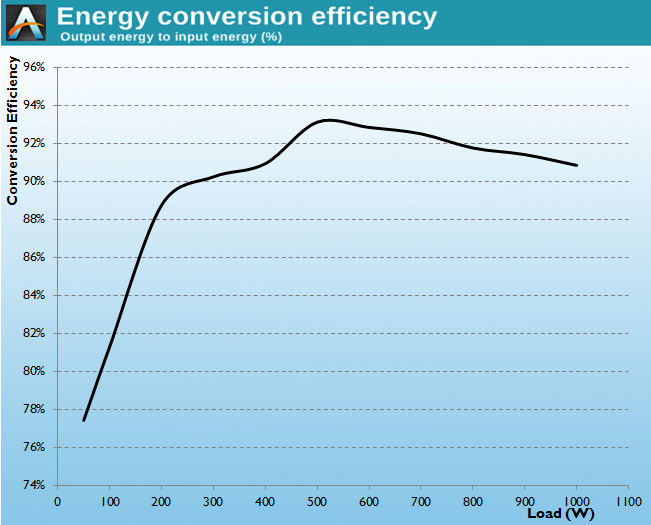
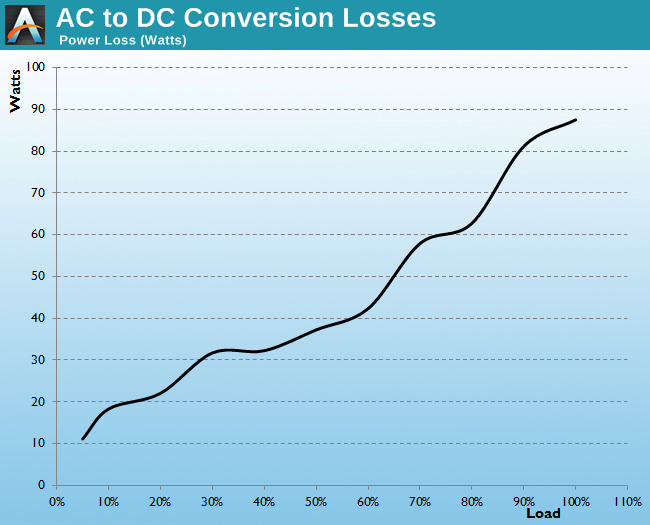
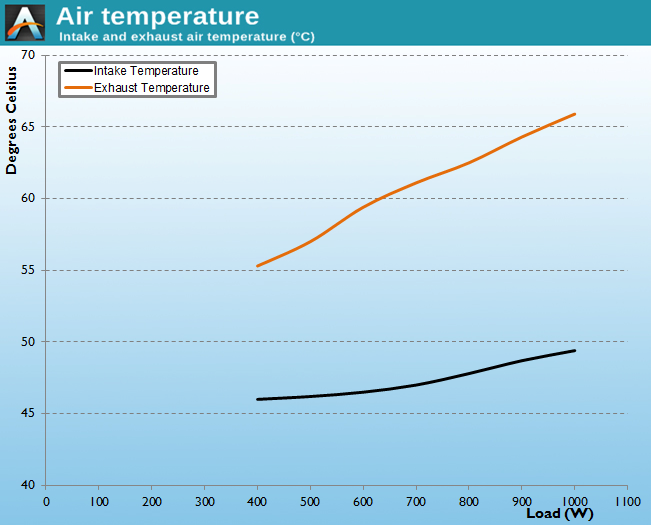
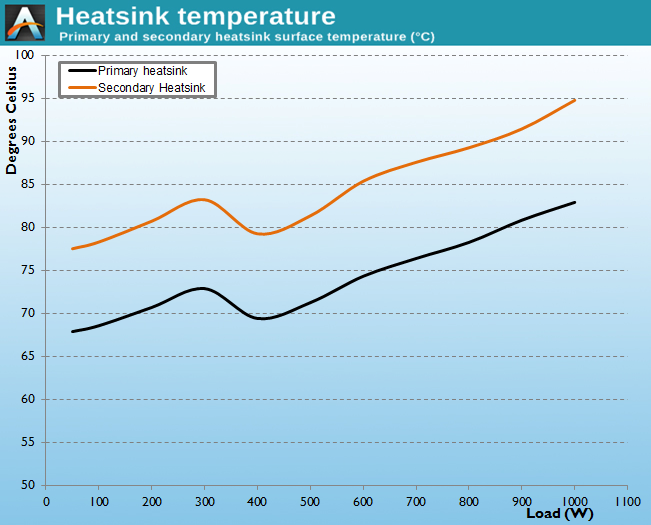
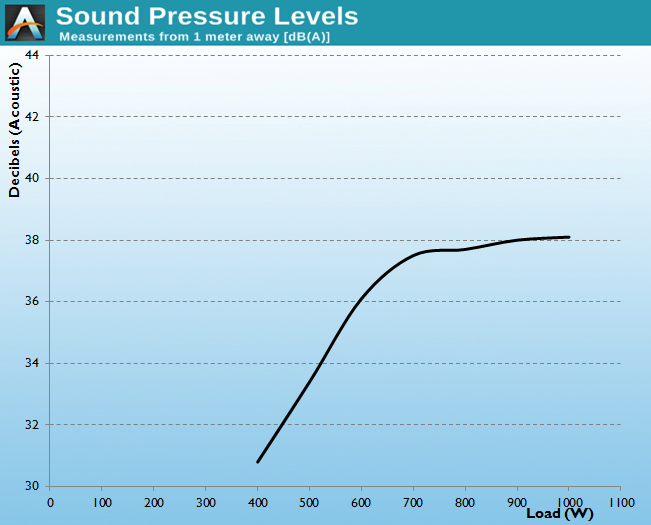








55 Comments
View All Comments
dirtyferret - Thursday, April 24, 2014 - link
too bad every professional reviewer disagrees with that opinionfrewster - Thursday, April 24, 2014 - link
Thanks for the good laugh. There seems to be an influx of people who believe that any PSU not made by Seasonic is trash, but that's BS.meacupla - Saturday, April 26, 2014 - link
The fan itself is a cheap sleeve bearing type.I don't understand why these companies opt for fans that can't be orientated horizontally without increased wear and noise. And the thing is, the price difference between a sleeve and double ball bearing fan is only about $1
benbenkr - Monday, May 12, 2014 - link
There's one issue these pro reviewers never seem to mention, coil whine. It doesn't inherently make a PSU bad, but boy it is annoying.I just replaced a RM650 due to the insane coil whine it has, even at low level loads.
The CWT made RM Corsair PSUs are quite solid, credit where it is due. But the coil whine is ridiculous. For that, I needed to change to a Seasonic KM3-based platform in the spirit of a Cooler Master (I know, a brand notorious for horrible PSUs) V700.
frewster - Thursday, April 24, 2014 - link
I don't think you know what you're talking about. Those ones made by Chicony? They're on par with Delta quality PSUs. And CWT? Hardly "horrible."YoloPascual - Saturday, April 26, 2014 - link
Yeah the server psu's that are made by Chicony are on par with Delta. The RM750 and RM850 are not. CWT made HX series are very good. CWT made RM series are mediocre at its finest. I does not need to be Seasonic/Super Flower made, but it should competent.just4U - Thursday, April 24, 2014 - link
I wish they'd use seasonic more.Voldenuit - Thursday, April 24, 2014 - link
I have a CWT ODM Corsair CXM-500 in my rig. My beef with it is that while it is pretty quiet at idle, running a GPU load (gaming, video benchmarks) on my GTX 760 will bring the fans up until it becomes the noisiest component in my system.Running a pure CPU load (undervolted i5 4670K) such as Prime95 does not elicit this behaviour, and I've controlled for other variables such as case, CPU and GPU fan speeds, so the threshold for "noisiness" from the PSU seems to be around 200-250W, which would correspond to a 40-50% load on the PSU.
It's not unbearable, and not worth returning or exchanging the unit, but it was a bit disappointing for me since I was trying to build as quiet a system as I could on my budget.
Voldenuit - Thursday, April 24, 2014 - link
PS It's worth noting that I don't have any sound measuring equipment, so I don't have any SPL measurements, and that my personal threshold for noise and my apartment noise floor might be very different from others'.I've seen posts both praising and condemning the same CX-500M (sorry, had the model number mixed up in OP), so YMMV.
lorribot - Thursday, April 24, 2014 - link
Does truly have a "chamfered edges and the rimmed bottom" as you state in the conclusion or should that be a ribbed bottom?